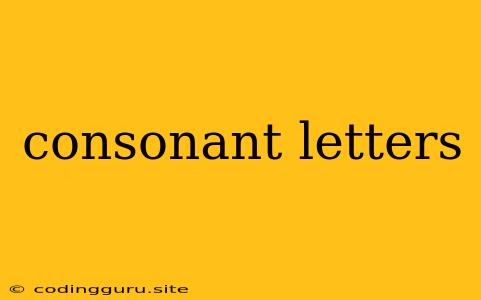Consonant Letters: The Building Blocks of Speech
Consonant letters are the foundation of written language, forming the backbone of words and shaping their pronunciation. But what exactly are consonant letters, and how do they differ from vowels? Let's dive into the fascinating world of consonants!
What are Consonant Letters?
Consonant letters represent sounds made by partially or completely obstructing the airflow from your mouth and/or nose. Imagine saying the sound "b" or "m". You'll notice that your lips close, creating a barrier to the air. This obstruction, however brief, is what defines a consonant.
Distinguishing Consonants from Vowels
Unlike vowels, which are created with an open airflow, consonants involve a restriction. You can't pronounce a consonant without using your tongue, lips, or teeth to create some form of blockage. Try saying "a" or "e" - your mouth stays open. Now try "t" or "d" - you'll feel your tongue touching your teeth or the roof of your mouth.
The Importance of Consonant Letters
Consonants are essential for:
- Clarity and Distinction: Consonants provide the shape and definition of words, helping us to differentiate between similar-sounding words like "bat" and "bet".
- Rhythm and Flow: Consonants add rhythm and cadence to language. Think about the difference in pronunciation between "cat" and "coat". The "t" sound adds a distinct stop in "cat" that is absent in "coat".
- Expressing Emotion: Consonants can be used to express different emotions. A harsh consonant like "k" can sound aggressive, while a softer consonant like "s" can sound more gentle.
Types of Consonant Letters
Consonant letters can be categorized based on several factors:
- Place of Articulation: Where in your mouth the obstruction occurs (e.g., lips, teeth, roof of mouth)
- Manner of Articulation: How the airflow is obstructed (e.g., stopped completely, partially blocked)
- Voicing: Whether your vocal cords vibrate (voiced) or not (unvoiced)
Examples of Consonant Letters
Let's take a look at some common consonant letters and their sounds:
- Stops: "b", "p", "t", "d", "g", "k" (airflow is completely stopped)
- Fricatives: "f", "v", "s", "z", "th", "sh" (airflow is partially obstructed, creating a friction sound)
- Nasals: "m", "n", "ng" (air escapes through your nose)
- Liquids: "l", "r" (airflow is partially obstructed, but more fluid than fricatives)
- Glides: "w", "y" (these are sometimes considered semi-vowels, as they glide into a vowel sound)
Consonant Letter Combinations
Consonant letters can also be combined to create more complex sounds, such as:
- Digraphs: Two letters representing a single sound (e.g., "ch" in "chair")
- Trigraphs: Three letters representing a single sound (e.g., "tch" in "catch")
- Blends: Two or more consonants that are pronounced separately (e.g., "bl" in "black")
Learning Consonant Letters
Learning consonant letters is crucial for developing literacy skills. Here are some tips for teaching and learning consonants:
- Start with simple sounds: Introduce consonants with clear, distinct sounds like "m", "b", and "t".
- Use visual aids: Use flashcards, pictures, and objects to help children associate letters with sounds.
- Practice through games and activities: Make learning fun with activities like "I Spy" using consonant sounds or building words with letter blocks.
- Connect letters to spoken words: Encourage children to listen for consonant sounds in words and practice saying them.
The Importance of Consonant Letters in Language Development
Consonant letters play a fundamental role in language development:
- Speech Development: Learning consonant sounds helps children develop clear and understandable speech.
- Reading and Writing: Understanding consonant letters is essential for decoding written words and expressing ideas in writing.
- Cognitive Development: The process of learning consonant sounds helps children develop their cognitive skills, such as memory, attention, and problem-solving.
Conclusion
Consonant letters are the unsung heroes of language, providing structure, clarity, and emotion to our words. From the simplest sounds to complex combinations, consonants contribute to the richness and complexity of language. Understanding and learning consonant letters is a fundamental step in acquiring literacy skills and unlocking the power of communication.
